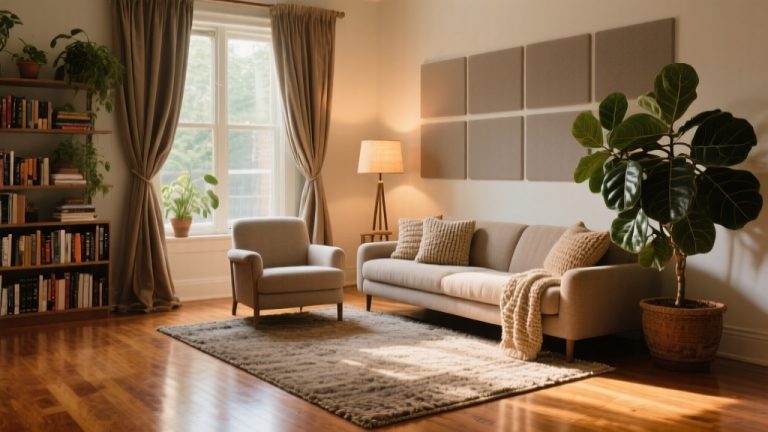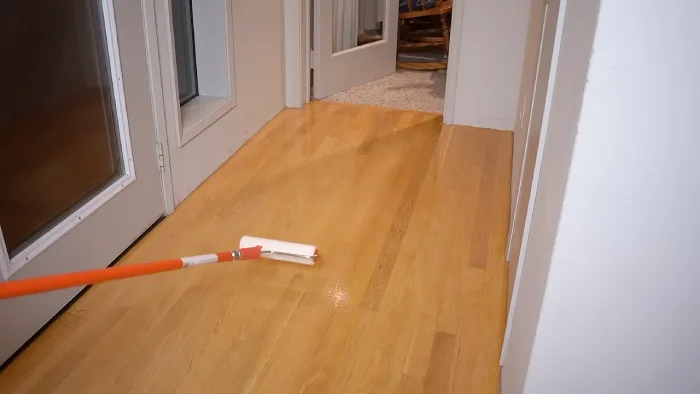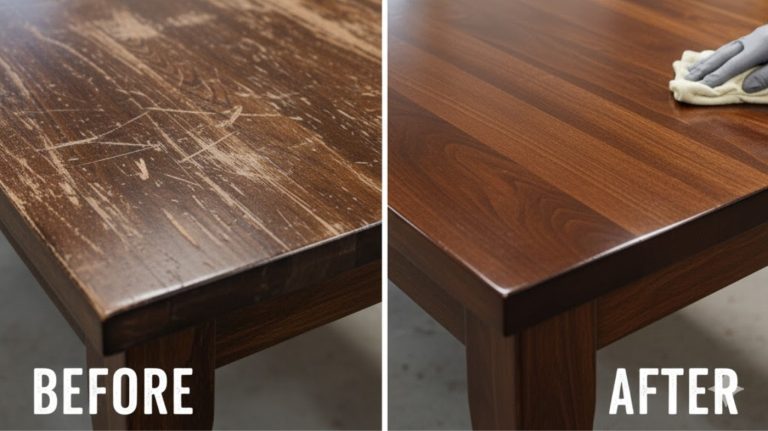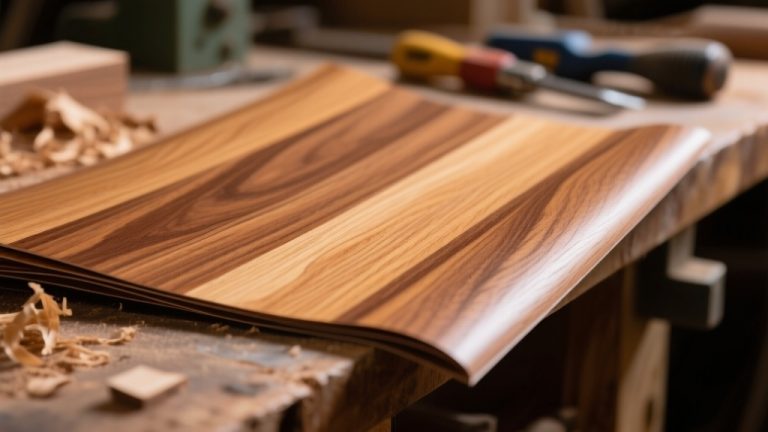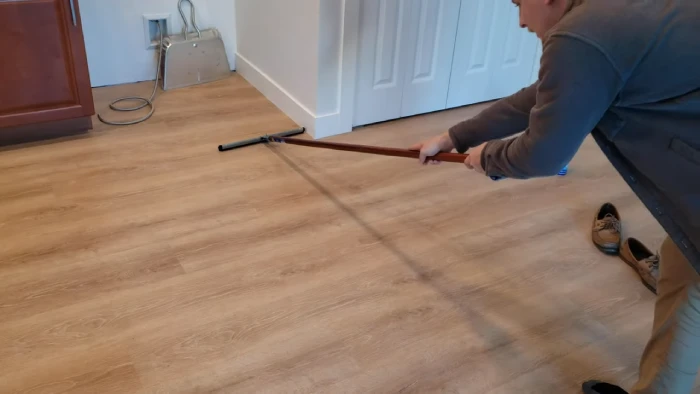Yes, bleach can harm wood by breaking down its fibers and weakening its structure, which makes the surface more prone to dents and scratches. It often causes uneven discoloration and can strip or damage existing finishes, leading to peeling or rough patches.
Residual chemicals may interfere with future coatings and cause long-term fading. Using bleach without proper care or neutralization risks swelling and warping from moisture. If you want to protect your wood, understanding these effects and how to manage them is essential.
Key Takeaways
- Bleach degrades lignin and wood fibers, weakening structural integrity and increasing susceptibility to damage.
- Residual bleach salts and moisture can cause ongoing deterioration, swelling, and warping, especially in softwoods.
- Bleach causes irreversible discoloration, uneven lightening, and potential long-term fading or altered wood tones.
- It strips existing finishes, reducing adhesion and causing peeling or flaking of new coatings.
- Proper neutralization, controlled application, and testing help minimize chemical damage and visual defects on wood.
Chemical Effects of Bleach on Wood Structure
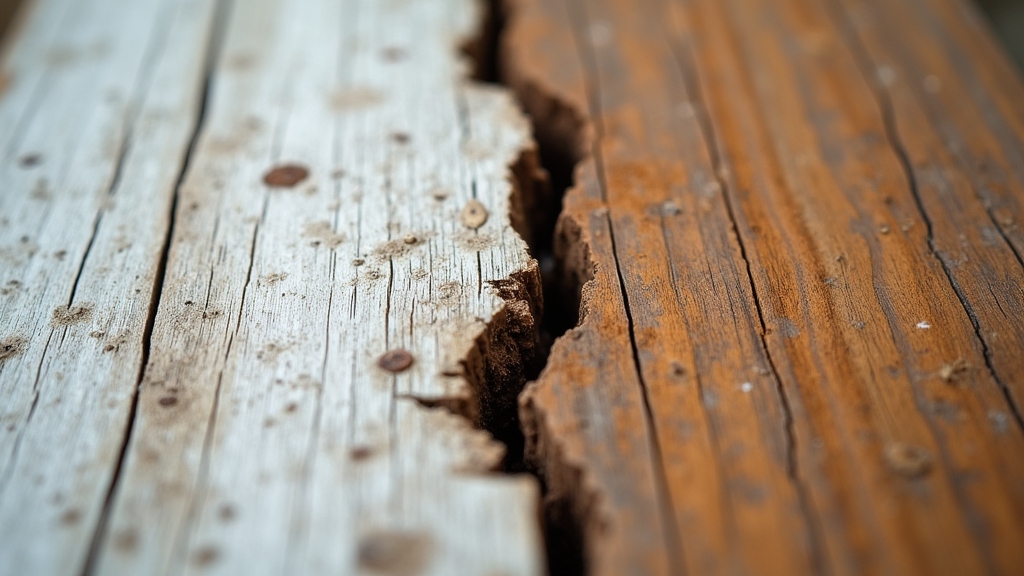
Although bleach is commonly used for cleaning and whitening wood, its chemical effects can especially alter the wood’s structure. When you use chlorine bleach (sodium hypochlorite), it degrades lignin, the polymer that hardens and strengthens wood cell walls.
This leads to weakened fibers and softer wood over time. Chlorine bleach destroys lignin, weakening wood cell walls and resulting in a loss of cellular integrity. Proper cleaning methods, such as gentle sweeping or vacuuming with soft attachments, can help maintain wood integrity and reduce the need for harsh chemicals.
Bleach dissolves cell wall components, creating pores and voids that increase permeability and vulnerability to further damage. If you don’t rinse thoroughly, bleach residue salts, like sodium crystals, accumulate and worsen fiber breakdown.
Oxalic acid bleach behaves differently; it can deposit crystal particles within pores, sometimes increasing hardness depending on the wood species and treatment method.
Visual Changes and Discoloration Caused by Bleach
When you apply bleach to wood, you can definitely expect it to lighten up quite a bit. The bleach works by breaking down the natural pigments in the wood. However, this process isn’t always smooth sailing. You might end up with some uneven discoloration patterns. Using gentle cleaning techniques can help minimize damage during cleaning.
It’s especially noticeable on woods that have varied grain or knots, which can make the end result feel a bit unpredictable. So, keep that in mind before you dive in! It’s important to note that multiple coats may be necessary to achieve a uniform lightening effect on darker woods.
And here’s something to consider: over time, any residual bleach left behind can keep altering the wood’s appearance. This means you could face long-term visual changes that you’ll need to manage carefully.
Bleach-Induced Color Lightening
Because bleach interacts differently with various wood pigments and species, understanding its impact on color lightening is essential before application. The choice of wood type can influence how the bleach reacts and the final color outcome, as some woods have natural pigments that respond uniquely to bleaching.
Two-part wood bleach chemically alters pigments, effectively lightening wood, while household chlorine bleach mostly removes surface stains without affecting intrinsic color. Oxalic acid targets rust stains but doesn’t bleach pigments.
Bleaching may cause temporary darkening and grain raising, requiring sanding afterward. It is important to remove existing finish before bleaching to ensure the chemicals penetrate and lighten the wood effectively.
| Bleach Type | Effect on Color | Recommended Use |
|---|---|---|
| Two-part bleach | Removes natural color | Deep color lightening |
| Chlorine bleach | Surface stain removal | Light cleaning, minor discolorations |
| Oxalic acid | Rust and iron stain removal | Stain-specific applications |
| Post-bleach care | Grain raising, sanding needed | Smooth finish restoration |
Test on scrap wood to gauge species-specific results, as some woods used in hardwood flooring may have different reactions to bleaching agents.
Uneven Discoloration Patterns
Understanding how bleach interacts with wood color is only part of the picture; you also need to contemplate how uneven application and wood characteristics can create inconsistent discoloration patterns.
When you apply bleach against the grain or with irregular strokes, patchy blotches often appear.
Wood species differ in porosity and tannin content, causing some sections to absorb bleach unevenly, especially knots or sapwood. Two-part bleach is often preferred for achieving a uniform natural look on high-tannin woods.
Residual finishes or moisture inconsistencies further disrupt uniform bleaching.
Over-saturation or multiple coats without proper drying result in streaks and irregular lightening. To achieve the best results, it is also important to prepare the surface properly using underlayment techniques that can help stabilize and level the wood before bleaching.
To avoid these issues, sand thoroughly, apply bleach with a brush following the grain, and use thin, controlled layers, allowing full drying between coats.
Testing on a small area helps predict outcomes, while neutralizing bleach stops ongoing color shifts, ensuring a more consistent, even finish.
Long-Term Appearance Effects
Bleach can cause significant long-term changes to the appearance of wood that you mightn’t notice immediately after application.
Over time, it breaks down lignin, weakening the wood’s surface and causing finishes to peel or flake. You may see uneven discoloration as some wood species lighten more than others.
Sodium hypochlorite residues can form crystals that impair finish adhesion. The wood’s color often fades gradually, sometimes unevenly, revealing patches or altered tones months later.
Surface texture can become rough or fuzzy, reducing gloss and smoothness. These subtle changes often emerge only when you apply a finish or after weather exposure. Additionally, wood’s susceptibility to moisture and temperature fluctuations can exacerbate these effects, especially if proper climate control is not maintained.
Household chlorine bleach, while useful for brightening, does not remove the natural wood color but can brighten or even out discoloration, especially greenish-gray tones.
To maintain appearance, you’ll need proper cleaning, sanding, and possibly re-staining or refinishing to correct bleaching’s long-term visual effects.
Impact of Bleach on Wood Finishes and Coatings
When you apply finishes or coatings over wood that has been exposed to bleach, you must prepare the surface carefully to guarantee proper adhesion and appearance.
Bleach weakens wood fibers and damages lignin, reducing surface integrity critical for bonding. You need to remove damaged fibers through thorough sanding or media blasting. Ensure the wood is completely dry before applying any finishes to prevent adhesion issues caused by residual moisture post-bleaching drying.
Proper drying is essential as it affects the curing process of subsequent treatments. Also, verify no sodium hypochlorite crystals remain, as they interfere with finish adhesion, especially on water-based products.
Residual bleach chemicals must be neutralized and fully removed to avoid peeling or adhesion failure. After bleaching, lightly sand to smooth raised fibers and promote uniform finish application.
Use multiple thin coats rather than heavy layers, and avoid dark stains that could mask bleaching effects. Testing finishes on a small area beforehand helps prevent unexpected adhesion or appearance issues.
Risks Associated With Using Bleach on Wood Surfaces
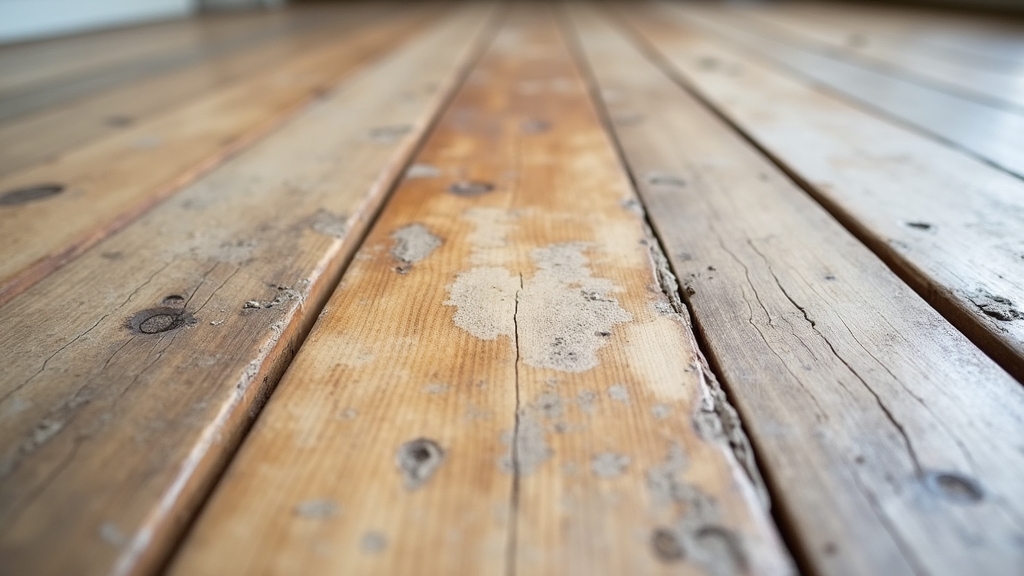
Although bleach can effectively clean wood surfaces, it carries significant risks that can compromise both the appearance and structural integrity of the wood.
Sodium hypochlorite breaks down wood’s natural fibers and lignin, weakening its structure and making it prone to dents and scratches. This structural weakening can worsen over time, increasing the likelihood of permanent damage.
Bleach can cause uneven discoloration and stain wood permanently, often requiring complete refinishing to fix. It is essential to allow the wood to fully dry before any refinishing to avoid further damage during the finishing process.
Bleach may permanently stain wood, causing uneven discoloration that often necessitates full refinishing.
It also strips existing finishes, reducing adhesion and causing new coatings to peel prematurely. Residual bleach crystals embedded in the wood further interfere with finishing. Additionally, rinsing bleach introduces moisture, risking swelling and warping, especially in softer woods.
You should weigh these risks carefully before using bleach, as damage often demands costly repairs like sanding or finish removal to restore the wood. Using proper protective measures such as drop cloths and plastic sheeting during any subsequent finishing work can help minimize further damage.
Different Types of Bleach and Their Specific Effects
Since different types of bleach affect wood in distinct ways, understanding their specific properties helps you choose the right product for your project.
Household chlorine bleach lightens surface stains but rarely changes deep wood color. Its effect can be enhanced when combined with proper sealing to protect the wood.
Two-part wood bleach offers stronger lightening, altering even dark woods but risks removing character.
Oxalic acid targets stains without bleaching the wood itself, restoring original appearance gently. The chemical composition and application method significantly influence post-bleaching surface properties.
Consider these points:
- Household bleach works best on surface discoloration and requires sunlight to enhance effects.
- Two-part bleach deeply lightens hardwoods like red oak but may flatten tonal variations.
- Oxalic acid is ideal for removing rust or tannin stains, safe for delicate fibers.
Wood species react differently; always test on scrap wood to avoid unwanted results.
Steps to Repair and Mitigate Bleach Damage on Wood
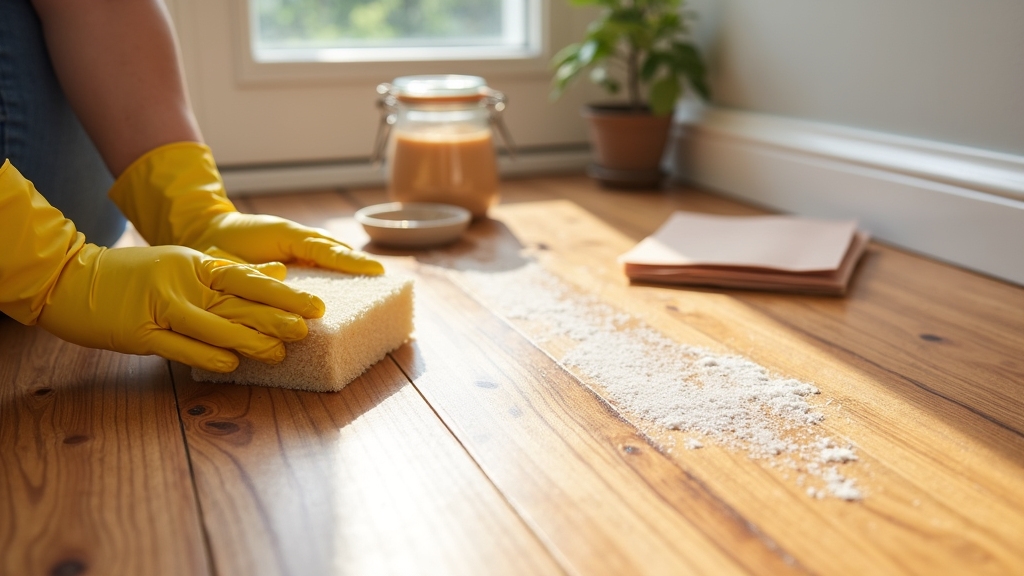
Before you start repairing bleach damage on wood, assess the affected area carefully to determine the extent of discoloration or finish deterioration. It is important to note that cleaning methods should avoid excessive moisture to prevent further damage to the wood.
Clean the surface gently with mild detergent and water, avoiding harsh chemicals. It is important to work in a well-ventilated space with protective gear when handling bleach or its residues. Sand the damaged area starting with 120-grit sandpaper, progressing to 220-grit for smoothness.
Match wood stains to restore color, then apply conditioners and protective finishes. Severe damage may require board replacement. Maintaining proper finish curing time is crucial to ensure the wood’s durability after repair.
| Step | Tool/Material | Purpose |
|---|---|---|
| Cleaning | Mild detergent, water | Remove residue without damage |
| Sanding | 120-220 grit sandpaper | Remove stains; smooth surface |
| Finishing | Wood stain, sealer | Restore color; protect wood |
Best Practices for Testing Bleach on Wood Before Use
When testing bleach on wood, you need to take careful safety measures and prepare the surface properly to achieve accurate and safe results. Start by removing any finish and sanding lightly to open the grain.
Clean the surface thoroughly and choose an inconspicuous test spot. Always wear gloves, eye protection, and work in a ventilated area to avoid harm. Note that different wood species react differently to bleaching agents, as some woods like beech and mahogany bleach easily, while others such as pine and poplar are more difficult to bleach satisfactorily wood species sensitivity.
Using a non-toxic, biodegradable cleaner before bleaching can help remove surface contaminants and improve results. Keep these key points in mind: Use the appropriate bleach type for your goal (e.g., household or two-part bleach).
Apply bleach along the grain with a brush or sponge. Let it sit 10–30 minutes, then wipe off excess. Allow the test patch to dry fully before evaluating color changes. This method helps you predict results and avoid damage on the full piece.
Frequently Asked Questions
Can Bleach Harm Wooden Outdoor Furniture Differently Than Indoor Wood?
Yes, bleach can harm your outdoor wooden furniture differently than indoor wood. Outdoor wood faces more moisture, sunlight, and tannins. Bleach may raise the grain more and cause surface degradation if used excessively.
You’ll need to sand and seal outdoor pieces after bleaching to protect them. Indoor wood usually only needs occasional stain removal, so bleach effects are less severe. Always use milder solutions for outdoor wood to preserve its integrity.
Is It Safe to Use Bleach on Antique Wooden Items?
It’s generally not safe to use bleach on antique wooden items without caution.
You should test a small area first because bleach can weaken fragile wood fibers, remove historical patinas, and cause uneven discoloration.
If you proceed, avoid over-application and neutralize the bleach afterward.
Consider safer alternatives like oxalic acid for stains.
When in doubt, consult a restoration professional to protect your antique’s value and integrity.
How Does Bleach Affect Wood’s Resistance to Mold and Mildew?
Bleach is like a flashlight in a dark room. It temporarily exposes mold and mildew but doesn’t change the wood’s inherent resistance.
You’ll kill surface mold, but it won’t strengthen the wood or prevent regrowth. To truly protect wood, you need proper drying and physical removal of mold.
Plus, thorough rinsing is essential to avoid chemical residue that can attract moisture and weaken the wood’s natural defenses over time.
What Alternatives to Bleach Are Safe for Cleaning Wood?
You can safely clean wood using oxygen bleach (sodium percarbonate), which removes stains and mold without damaging fibers. Natural acidic cleaners like white vinegar and lemon juice effectively tackle grime and mildew while being gentle.
Baking soda and hydrogen peroxide also work well, offering deodorizing and disinfecting benefits without harsh effects. For enhanced antimicrobial action, add essential oils like tea tree oil.
Eco-friendly commercial wood cleaners combine these ingredients to protect wood and the environment.
Can Bleach Damage Wood Flooring Under Radiant Heating Systems?
Using bleach on wood flooring under radiant heating systems is like pouring acid on a delicate flower. It can worsen damage quickly.
You’ll find that heat speeds up bleach’s chemical breakdown of finishes and wood fibers. This increases risks of discoloration, warping, and cracks.
If you must use bleach, dilute it heavily, rinse immediately, and avoid prolonged exposure. This helps minimize accelerated deterioration caused by the combined effects of heat and chemicals.
Save Your Surfaces From Permanent Bleach Damage
If you think a splash of bleach won’t wreck your wood, think again. It can strip finishes, cause ugly discoloration, and weaken the very fibers holding your wood together.
You don’t want your beautiful surfaces turning into a blotchy disaster zone. Always test on a hidden spot first and handle bleach with extreme care. Following the right steps can save your wood from irreversible damage and keep it looking flawless for years to come.

